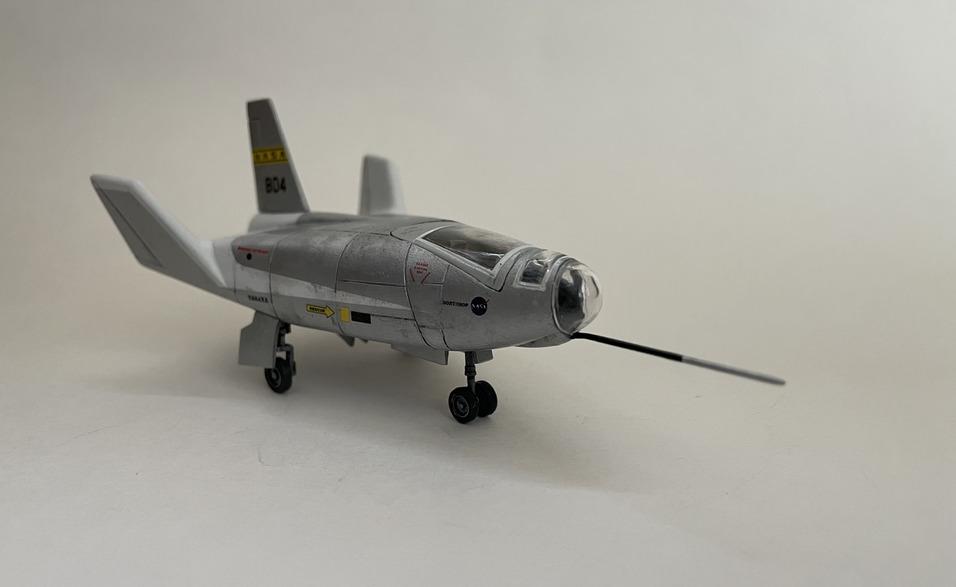1/72 Anigrand HL-10 Lifting Body
A lifting body is a craft whose body, rather than its wings, generates lift. NASA and the US Air Force researched lifting bodies in the 1960s and 1970s as potential spacecraft designs that could glide to a landing after leaving orbit. A glider with wings would presumably be steerable, endowing the craft with some latitude in choice of landing sites; however, the stresses and heating during re-entry together with hypersonic velocities would be challenging for wings to weather. And so, the lifting body simply does without them.
The Northrop HL-10 (HL = horizontal landing) flew from 1966 to 1975 at NASA's Flight Research Center at Edwards AFB, California. It was the highest and fastest flying of the lifting bodies, at 90K feet and Mach 1.86. The HL-10 would be flown via B-52 to 45K feet and dropped; the XLR-11 rocket would fire for at most 100 seconds, increasing the craft's speed and altitude. Then the HL-10 would glide to a flare-out landing on Rogers Dry Lake at Edwards. Although the HL-10 never evolved into a spacefaring ship, important lessons were learned that informed the development of the Space Shuttle and later lifting bodies.
The Kit
The 1/72-scale Anigrand HL-10 has 23 resin parts and 3 clear vacu-formed canopy pieces. The decals are for the single NASA HL-10 article 804. Anigrand Craftworks is a Hong Kong-based model company “specializing in unusual, experimental, and conceptual aircraft and spacecraft”, many of which are not offered by other vendors. This is my first Anigrand kit and I'm pretty happy with it (incidentally, shipping is relatively fast and inexpensive, and customer support is prompt).
This is a tiny model:
At this scale, panel lines can run a little deep and that's the case here. The only other nit is that the canopy didn't fit well, and required some putty work.
The two fuselage halves didn't fit perfectly, but some Mr. Dissolved Putty did the trick:
My biggest concern with this build was not ending up with something that looked like a tin toy. A good metallic finish will make or break this model, as will the visibility of seams. I'm new to NMF and so I was keeping my expectations in order.
I struggled to get the proper metallic finish I was after, noting that my issue with high-shine Alclad finishes (like chrome or high shine aluminum) is that the black gloss base always goes down a little grainy for me, ruining the smooth surface needed for a realistic, high-shine finish:
I wasn't happy with this grainy chrome, since it looked really fake.
I re-primed with Alclad 302 gray primer/microfiller (which is really quite nice, btw), and then went over with chrome. I hit a few of the panel lines with high-shine aluminum (ALC 126), and masked around and painted a few panels high-speed silver (ALC 125) to give contrast. Still not the look I'm after, but an improvement over the first finish:
For weathering, I did an enamel pin wash (Tamiya Gray), following by some chipping with Tamiya Dull Aluminum XF-16. I also dry-brushed some of this on in various places to create some dull flecks here and there. To better achieve a tarnished look, I then stippled on some Tamiya gray pigment, which created some small blotches that I then tried to spread out a bit. To get finer-sized imperfections, I used AK weathering pencils (dirty white, gray, aluminum). Lastly, I stippled and blended some Mig Oilbrushers starship filth on various panels and the flight control surfaces. I'm still very new to NMF and NMF weathering, and I'm not sure if the final look is what I was after, but it's close.
I didn't seal the model after decals or weathering, since I didn't want to mess with the natural finishes of the Alcald, or the pigments and oils.
Lastly, the kit did not come with the sensor nose boom, so I used a bit of scrap copper rod, suitably bent.














Nice build up of a difficult kit. I built one years ago but not with your nice results.
Nice job Brian, I bet it was a real thrill to pilot that bad boy.
A wonderful result out of a definitely challenging kit, Brian!
A fantastic chosen subject and an equally wonderful article!
Excellent result on this tiny kit, Brian @bapowellphys
To me the NMF together with the weathering does look very nice.
The nose boom is also nicely done.
Cool model and excellent build!
Indirectly made famous by the Six Million Dollar Man when Hollywood thought we wouldn't notice such things as the difference between the M2-F3 whose footage we saw crash in the opening sequence and the HL-10 which was launched initially.
We can rebuild him, we have the technology...
Try Vallejo acrylic metallics - they beat @#$#@! AlClad all to you-know-where.
Nice work and a very good result with this unusual model.
I'll check them out, thanks Tom! I'm actively looking for good metallics.
"Flight Com! I can't hold her...she's breaking up! she's breaking up!...Steve Austin, astronaut, a man barely alive. ...Gentlemen, we can rebuild him. We have the technology." Great build of a very unusual subject. Brian, @bapowellphys .
https://youtube.com/watch?v=cRgqouS1O6E&feature=shares
You put a lot of work into this tiny model, Brian, and it was definitely worth it, the end result is brilliant.
What a strange little thing! Nice job.
Great job, nice to see one built.
I want one of these, along with several other of Anigrand's offerings. You did a superb job with this one!